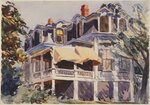

IN JULY 2023, Gloucester’s Cape Ann Museum will launch, “Edward Hopper & Cape Ann: Illuminating an American Landscape,” an exhibition of the critically acclaimed American artist during a turning point in his life and career when he came to Cape Ann from 1923-1928, following an initial visit in 1912. The exhibit will feature 65 paintings, watercolors, drawings, and prints brought together from the Whitney Museum of American Art, the Brooklyn Museum, the Museum of Fine Arts, Boston, National Gallery of Art in Washington, D.C., the Philadelphia Museum of Art, the Edward Hopper House & Study Center, and 24 other institutions and private lenders. We spoke with Elliot Bostwick Davis, Ph.D., curator of this once-in-a-generation exhibit.
Dr. Davis: This is really the first, and, I believe, the largest exhibition ever devoted to Edward Hopper and his artist wife, Josephine ‘Jo’ Nivison Hopper on Cape Ann. It’s exciting. In all, 65 works will be featured, starting when Hopper is a totally unknown artist, seeking to find his voice, and we focus on five extraordinary summers on Cape Ann, following his first visit in 1912 and focusing on 1923 onwards when I believe he really comes into his own. This exhibit celebrates the 100th anniversary of those summers, and it’s also linked to Gloucester’s 400+ anniversary celebration happening this year. In the end, viewers will be able to go on this journey with Edward Hopper, as well as with Jo Nivison, and see how his work is transformed during their visits here.
(CAM Executive Director) Oliver Barker approached me in 2020 with this idea to commemorate Edward Hopper in a significant way in 2023. I had worked in 2007 on Hopper's early work while at the Museum of Fine Arts, Boston for the last big US Edward Hopper retrospective. Also, I knew the Cape Ann Museum’s collection because I produced my first catalog for them when I was at the Metropolitan Museum of Art in New York, in 1993, so there’s a ‘coming back’ sense for me with this summer’s exhibit. I love that.
Cape Ann was a transformative catalyst for Edward Hopper’s work. This is where he finds inspiration with maritime themes. This is where he embraces scenes of modern New England, with beautiful landscapes and the unique and varied architecture around Cape Ann. And he does this with a fellow artist (and future wife) Jo Nivison, who in 1923 is the more established artist. They fall in love here. She encourages him to try watercolor, the foremost medium of American modernists during the 1920s. She becomes his advocate and eventually takes on the role as a producer for his artistic career.
There are so many. One highlight is the many pieces connected to Hopper’s often underappreciated fascination with sailboats. Hopper grew up just two blocks from the Hudson River waterfront in Nyack, New York and by the time he was 12, he was over six feet tall and was bullied by other children, which may have caused him to become introverted and contrarian. Hopper’s father suggested they build a catboat together to sail on the Hudson, which they did. So, in this exhibit, we have three of his childhood boat models and a series of catboat etchings from 1922 that are very much a reprise of Winslow Homer’s Breezing Up, which shows a catboat with Gloucester painted on the stern. Homer’s painting is an inspiration for Edward Hopper. We also feature two drawings of Gloucester boats, including the Henry Ford, the famous schooner built in Essex, MA, which won the International Fishermen’s Cup Race in 1923, culminating the events of that summer.
It’s the landscape, the light and the artistic legacy. There is something the granite with its mica flecks in the seabed—that sparkling sense of Cape Ann formed by the glaciers that makes it so spectacular. And then there are the important themes of the day that were represented on Cape Ann and in Gloucester. There was a feeling of a New England community adapting to modernization. The train yards. A working fishing port. Immigration, with the Italian and Portuguese communities. These are all the themes of the time, and they are very prominently represented by works on view in this show.
They met at the New York School of Art in New York through their art teacher, Robert Henri. From Jo’s published journals, we know they met in a hallway at the school. Hopper, maybe because of his experience as a catboat builder, helped her stretch a canvas. She was quite petite—barely 5’2”—and he was over 6’4”.
By 1923, when they arrived in Gloucester together, Jo was already supporting herself as an artist. She had a teaching degree in art from what is now New York’s Hunter College and was working in Manhattan’s Lower East Side teaching children, many from newly arrived immigrant families. Watercolor—popular among American modernists at the time—was her favorite medium because it had a certain freedom and spontaneity that suited her personality. It was also far less expensive for collectors to purchase watercolors than oil paintings, making the medium more accessible.
Like many artists, Jo Nivison and Edward Hopper traveled New England to paint. They painted in Gloucester and as far as north Maine. But something about Gloucester pulled them back. Edward Hopper was seeking to find his voice as an artist. Jo Nivison was a natural teacher, and she encouraged Edward to try new things. She encourages him to work outdoors in watercolor, and to paint what he loves, as Henri taught them.
By the summer of 1923, several of Jo’s watercolors had already been selected for a major show at the Brooklyn Museum devoted to watercolor. In November, before the show, Jo approached the museum’s curators and advocated for Edward Hopper's watercolors to be included.
Yes. And because of Jo, the museum offered to exhibit six of Edward Hopper’s Gloucester watercolors. From the exhibition catalog, which will be on view in the show, Jo may have had a hand in ensuring that Hopper’s paintings broadly represent Gloucester, including his painting of the mansard roof, as well as scenes from Gloucester’s Italian quarter. Hopper makes his first sale of The Mansard Roof to the Brooklyn Musuem for $100. He also receives a stellar review by Helen Appleton Reed, who links Hopper to Winslow Homer in terms of his ability to make things that would otherwise be passed over—the commonplace—beautiful.
They return to Gloucester in the summer of 1924. But Jo puts down an ultimatum because she had wanted to go to Provincetown, where she'd spent several summers. She tells Edward, ‘I'll go to Gloucester on one condition, that we're married today.’ He married Jo that day, on July 9, and they come to Gloucester for their honeymoon and stayed in a boarding house on Bass Avenue.
We couldn't do the show without the Whitney Museum. When Jo died in 1968, 10 months after her husband, she donated her collection of Edward Hopper’s and her own work to the Whitney. It was the largest bequest of work by any American artist ever given to an American museum and remains so today. The Josephine and Edward Hopper Bequest includes over 3,000 works by Edward Hopper, including everything from his childhood right up to his later work, and over 200 by Josephine N. Hopper.
That’s hard. But I think Hopper’s 1923 painting, The Mansard Roof is one favorite. There’s this exuberance to it. There’s joyfulness, with the sun-filled billowing breeze of Cape Ann represented by the side-by-side awnings, the architectural dormers, the foliage, and the shadows. What better house than this one on Rocky Neck, where all the artists were, and where he and Jo are falling in love?
There are also three oils Hopper completed during last summer on Cape Ann in 1928 that I do love. The Cape Ann Granite is just an extraordinary American landscape. It’s quintessential Hopper. Very stripped down. It features boulders of granite and shadows created by Cape Ann light stretching across the green landscape of Dogtown. It’s stunning.
Yes. Hopper obviously saw something he liked about Cape Ann in his initial visit in 1912, and he returned in 1923 because he hasn’t found his aesthetic, his artistic voice. When Edward Hopper arrived on Cape Ann in 1923, he’s desperate to break through as a painter. At the time, art critics were challenging American artists to paint what they consider distinctly American scenes. Hopper hated the term ‘American scene,’ but he took the idea of painting his immediate surroundings very seriously here. He painted the working waterfront of Gloucester. And he painted the great preponderance of housing, both modest New England clapboard homes, as well as the more elaborate ship captains’ residences.
You have to remember, as Edward Hopper gets older, by the early 1950s, he only produced about one or two oil paintings a year. But during these summers early in his career, Hopper is very prolific. He's finding his voice. He's making his way, and he's getting representation by a New York dealer, Frank Rehn, and he is receiving critical acclaim. And it’s during this decade, from 1923 to 1933, that he's becoming one of the foremost American artists of his day. It’s quite an amazing journey, and one that would not have been possible without Jo Nivison Hopper and their summer together on Cape Ann in 1923.